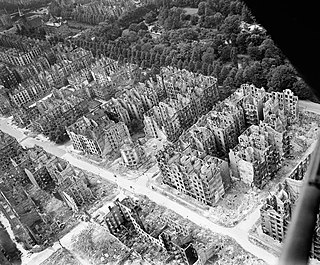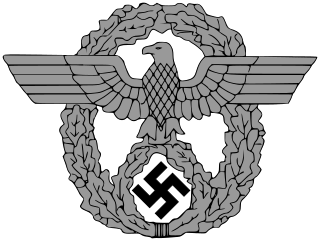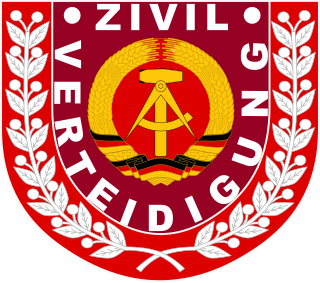
Civil defense or civil protection is an effort to protect the citizens of a state from human-made and natural disasters. It uses the principles of emergency operations: prevention, mitigation, preparation, response, or emergency evacuation and recovery. Programs of this sort were initially discussed at least as early as the 1920s and were implemented in some countries during the 1930s as the threat of war and aerial bombardment grew. Civil-defense structures became widespread after authorities recognised the threats posed by nuclear weapons.

The Allied bombing of Hamburg during World War II included numerous attacks on civilians and civic infrastructure. As a large city and industrial centre, Hamburg's shipyards, U-boat pens, and the Hamburg-Harburg area oil refineries were attacked throughout the war.

Chemical, biological, radiological and nuclear defense or NBC protection is protective measures taken in situations in which chemical, biological, radiological or nuclear hazards may be present. CBRN defense consists of CBRN passive protection, contamination avoidance, and weapons of mass destruction mitigation.

The Ordnungspolizei, abbreviated Orpo, meaning "Order Police", were the uniformed police force in Nazi Germany from 1936 to 1945. The Orpo organisation was absorbed into the Nazi monopoly on power after regional police jurisdiction was removed in favour of the central Nazi government. The Orpo was controlled nominally by the Interior Ministry, but its executive functions rested with the leadership of the SS until the end of World War II. Owing to their green uniforms, Orpo were also referred to as Grüne Polizei. The force was first established as a centralised organisation uniting the municipal, city, and rural uniformed police that had been organised on a state-by-state basis.

Kurt Max Franz Daluege was a German SS and police official who served as chief of Ordnungspolizei of Nazi Germany from 1936 to 1943, as well as the Deputy/Acting Protector of Bohemia and Moravia from 1942 to 1943.

The ranks and insignia of the Ordnungspolizei were developed in 1936 after the nationalization of Germany's regular police forces.
There were two main Police forces of Nazi Germany under the Reichsführer-SS, Heinrich Himmler from 1936:

Technische Nothilfe was a German organisation. It began as a strikebreaker organisation after the First and Second World Wars, but developed into a volunteer emergency response unit. During the Nazi period TN became in charge of technical civil defence.

The Civil Defence Service was a civilian volunteer organisation in Great Britain during World War II. Established by the Home Office in 1935 as Air Raid Precautions (ARP), its name was officially changed to the Civil Defence Service (CD) in 1941. The Civil Defence Service included the ARP Wardens Service as well as firemen, fire watchers, rescue, first aid post and stretcher parties. Over 1.9 million people served within the CD and nearly 2,400 lost their lives to enemy action.

The Reichsluftschutzbund was a civil defense organization in Nazi Germany in charge of air raid precautions in residential areas and among smaller businesses.

The Reich Postal Ministry in Berlin was the Ministry in charge of the Mail and the Telecommunications of the German Weimar Republic from 1919 until 1933 as well as of Nazi Germany from 1933 to 1945. After the Second World War, the Federal Ministry for Post and Telecommunications in West Germany and the Ministry for Post and Telecommunications in East Germany took over the postal system in their respective nations.

The Hilfspolizei was a short-lived auxiliary police force in Nazi Germany in 1933. The term was later semi-officially used for various auxiliary organizations subordinated to the Ordnungspolizei as well as various military and paramilitary units set up during World War II in German-occupied Europe.

Norwegian Civil Defence is the civil defence organization of Norway.

Erich Hampe was a German Army officer with the rank of generalmajor, who served as Chief of the Department for Technical Troops in OKH during World War II. Previously he was Vice Chief of the Technische Nothilfe as well as an editor and the author of the official history of German civil defense during the Second World War. During the postwar years, he served as the first president of the Federal Agency for Civil Defense.

The Schutzpolizei des Reiches or the Schupo was the state protection police of Nazi Germany and a branch of the Ordnungspolizei. Schutzpolizei is the German name for a uniformed police force. The Schutzpolizei des Reiches was the uniformed police of most cities and large towns. State police departments were in charge of protection police, Kripo criminal investigation divisions (Kriminalpolizei), and administrative police. The state protection police comprised a patrol branch, barracked police, traffic police, water police, mounted police, police communications units, and police aviation. Policemen were required to have previous military service, good physical and mental health, Aryan descent and membership in the Nazi Party.
Bahnschutzpolizei (BSP)(Railway Protection Police) in Nazi Germany was made up of full-time and part-time police officers who were employees of the Reichsbahn (state railways). The Bahnschutzpolizei was tasked with railway safety and also with preventing espionage and sabotage of railway property. It was not subordinated to Hauptamt Ordnungspolizei, only the Deutsche Reichsbahn.

Feuerschutzpolizei was a fire police unit in Nazi Germany and a branch of Nazi Germany's Ordnungspolizei, formed in 1938 when the German municipal professional fire brigades were transferred to the national police. The previously red fire vehicles, blue uniforms and fire service ranks were replaced by green fire vehicles, green uniforms and police ranks.
Luftwaffe personnel structure consisted of two broad categories, Wehrmachtangehörige or members of the armed forces, and Wehrmachtgefolge or auxiliaries of the armed forces.
The Ranks and insignia of German Women's Auxiliary Services were the ranks given to women who served in the German military and paramilitary forces during World War II.

The Civil defense of the GDR was an organization for the protection of the population, the economy, vital facilities and cultural values against the consequences of disasters and accidents. In the event of war, it should also serve to protect its own population from military operations.
















